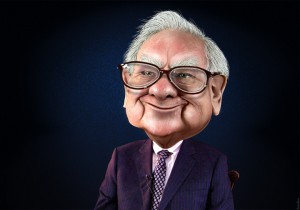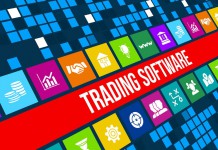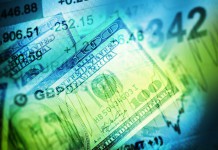 Stock exchanges in the United States account for about 40% of the capitalization of all exchanges in the world. The situation on the ocean floor should be of interest to all investors even if they do not invest directly in the US market, as the collapse of that market is likely to cause declines on other exchanges. You can imagine an upward movement on the emerging markets while consolidating the US market. It is hard to expect a bull market, for example on the Warsaw Stock Exchange, when Wall Street is going to have a strong bounce.
Stock exchanges in the United States account for about 40% of the capitalization of all exchanges in the world. The situation on the ocean floor should be of interest to all investors even if they do not invest directly in the US market, as the collapse of that market is likely to cause declines on other exchanges. You can imagine an upward movement on the emerging markets while consolidating the US market. It is hard to expect a bull market, for example on the Warsaw Stock Exchange, when Wall Street is going to have a strong bounce.
One of the most famous stock exchanges shown in many feature films and the largest in terms of capitalization is the New York Stock Exchange (NYSE). The capitalization of the New York Stock Exchange is about 19 trillion USD and the list of 2,400 companies listed on its stock exchange. For comparison, the stock market capitalization of the Warsaw Stock Exchange amounts to around 1.2 trillion PLN, or 300 million USD, and the number of listed companies is 486! Even the largest European stock exchange in Börse Frankfurt has a capitalization of around 2 trillion USD.
The NYSE was established in 1792 by 24 brokers who signed a contract on Wall Street under the tree buttonwood, hence the name Buttonwood Agreement. The brokers agreed on commissions on the transactions they made and gave priority to the transactions made for the members of the exchange. In 1817 began to rent space on the stock exchange floor. Previously, the trade was organized at Tontine Coffee House on Wall Street.
The main index listed on the New York Stock Exchange is the S&P 500. It is the index of the 500 largest capitals. Companies included in the index can be divided into several basic sectors:
- energy,
- materials,
- industrials,
- consumer discretionary,
- consumer staples,
- health care,
- financial,
- technology,
- telecommunication services,
- utilities,
- real estate,
 The National Association of Securities Dealers Automated Quotations (NASDAQ) is the second largest US stock exchange with a market capitalization of 6.8 trillion USD. The stock exchange was founded in 1971, two centuries later than the NYSE. NASDAQ until 2006 operated as a regulated over-the-counter market created by so-called market makers creating an alternative trading system for securities. NASDAQ is mostly famous for technology companies, and the biggest ones are Facebook, Amazon, Netflix, Alphabet the former Google, which is called “FANG” in the United States. The total number of listed companies is about 3 thousand. companies.
The National Association of Securities Dealers Automated Quotations (NASDAQ) is the second largest US stock exchange with a market capitalization of 6.8 trillion USD. The stock exchange was founded in 1971, two centuries later than the NYSE. NASDAQ until 2006 operated as a regulated over-the-counter market created by so-called market makers creating an alternative trading system for securities. NASDAQ is mostly famous for technology companies, and the biggest ones are Facebook, Amazon, Netflix, Alphabet the former Google, which is called “FANG” in the United States. The total number of listed companies is about 3 thousand. companies.
Revolution on Wall Street
In 1996, the American stock exchanges underwent real revolutions. The US Securities and Exchange Commission (SEC) after several years of testing allowed the introduction of alternative stock markets. So far, transactions have had to go through a stockbroker who has access to the stock market. The introduction of alternative stock exchanges allowed us to make transactions via the Electronic Communication Network (ECN).
With ECN, pending orders are directly linked to market orders, i.e. buy and sell orders at any price without a broker’s share. This allowed a significant reduction in transaction costs.
The ECN system guarantees complete anonymity and transparency, meaning that orders are executed independently of the market maker. The Americans went further and started offering bonus for liquidity additions, i.e. placing limit orders, and commissions were only charged for market orders. This means that you can earn additional profit only for purchases or sales with a limit order. Of course there is always the danger that our order will not be fulfilled or will be partially fulfilled.
Over the years, more and more stock exchanges began to emerge, and some of the more popular ones were:
- Direct Edge is now linked to BATS Global Markets,
- ARCHIPELAGO,
- and many others.
The famous book “Flash Boys” by Michael Lewis showed new threats of large dispersion of stock exchanges. HFT (High Frequency Trading) hedge funds, thanks to servers next to the stock exchange, provide faster access to stock market orders (fractions of a second). They had a look at Level II before he appeared on the market and additionally had very fast links, which allowed them to anticipate other players and offer the same stock a little more expensive, usually one cent, so-called front running. HFT traders earned a fortune on this type of business with very little risk. For example, GM shares are offered in the Level II at 30.00 / 30.01 BID / ASK, HFT trader sees a big player wanting to buy GM shares at a price of 30.01, so he prevents the buyer from buying the stock at that price, and then practically at the same time issues a sale order with a limit of the same stock at a price of 30.02. That means that this investor will buy GM shares one cent higher. This example is very simplified, and moreover the methods of using faster links by HFT companies are much more. However, the described HFT scheme shows that all trading system on the stock market will sooner or later be manipulated. Sadly, we have this in nature, comforting is the fact that more and more things are being talked about, among other things thanks to the mentioned book and that attempts are made to change that state.
A brief history of the crises in the American stock markets
The most famous collapse was the so-called Black Thursday, October 24, 1929, which led to the introduction of many legislative solutions to prevent such situations in the future, such as the need for financial companies to file financial statements. The cracking of the speculative bubble on the New York Stock Exchange was so much more serious that a large proportion of investors were buying stock for loans they were eagerly lending at the time to banks. At that time, it was thought that the main reason for such large falls was the introduction of the so-called short sale.
On Black Thursday Dow Jones Industrial Average lost about 11%, and after weekend on Black Monday 13%, followed by Black Tuesday at around 12%.
The stock market crashes in 1929 have probably started the biggest economic crisis in the world. Most people have lost their wealth on the stock market, businesses have started to collapse, and the US unemployment rate has reached 30%.
 Another famous Black Monday came on October 19, 1987. On this day, the DJIA index lost more than 22%, i.e. over 500 points. And it was the biggest percentage drop of this index in history. The cause of the crash was, among other things, a drop in oil prices in 1986 by about 50% as a result of the OPEC decision to increase production, a collapse in the bond market and the depreciation of the US dollar just before the crash on Wall Street. This time the scapegoat became an automatic trade, which at that time increasingly clambered on the American floors.
Another famous Black Monday came on October 19, 1987. On this day, the DJIA index lost more than 22%, i.e. over 500 points. And it was the biggest percentage drop of this index in history. The cause of the crash was, among other things, a drop in oil prices in 1986 by about 50% as a result of the OPEC decision to increase production, a collapse in the bond market and the depreciation of the US dollar just before the crash on Wall Street. This time the scapegoat became an automatic trade, which at that time increasingly clambered on the American floors.
Last crash on the New York Stock Exchange took place September 15, 2008. On this day, the fourth largest investment bank Lehman Brothers fell. The DJIA index recorded the strongest drop of 777 points, or 7%.
The stock market crashes were, and will be, still going to be long. This is related to credit growth, money supply growth and inflation. Those who are responsible for economic policy, ie fiscal and monetary policies, when they find that their expansive policies have over-stimulated the economy, inflation is out of control, they simply press the brakes, restricting credit by limiting money supply. There are many tools, interest rates, open market operations, etc. The economy is slowing down and falling into recession, then the people themselves are loosening politics, and the economy enters the recovery phase, eventually accelerating too much and the brake is pressed again. This process is called business cycles and has continued since the introduction of fiduciary money, which is not covered in any bullion, is based on the belief in the state institutions that print it.
How to start trading on American stock markets
Trade on the American stock markets can be started in several ways. It all depends on our capital and our knowledge. We can start by the following options:
- set up an account with an American broker,
- cooperation with proprietary trading company,
- set up an account with an offshore broker.
 Setting up an account with an American broker involves paying a minimum of $ 10,000, as US regulations impose an obligation on investors to pay a minimum deposit at a brokerage firm exactly in that size. If we are a day trader, which according to US law means 4 or more open and closed transactions in the same session during the week, then our deposit will have to be $ 25,000. This rule is called the Pattern Day Trader Rule (PDT Rule). Commissions usually reach $ 1 or more for 100 shares. Of course, the bigger the account, the bigger the box for negotiation.
Setting up an account with an American broker involves paying a minimum of $ 10,000, as US regulations impose an obligation on investors to pay a minimum deposit at a brokerage firm exactly in that size. If we are a day trader, which according to US law means 4 or more open and closed transactions in the same session during the week, then our deposit will have to be $ 25,000. This rule is called the Pattern Day Trader Rule (PDT Rule). Commissions usually reach $ 1 or more for 100 shares. Of course, the bigger the account, the bigger the box for negotiation.
Collaboration with a proprietary trading company is much less costly, with respect to the required deposit, as it usually ranges between $ 3 and $ 5,000. Proprietary trading companies associate many traders by offering them access to stock exchanges around the world, but they require a certain percentage of their profits. The so-called payout is usually 20% at the beginning, as long as cooperation falls to as much as 1%. We also need to pay extra for the platform, quotes, etc. This amount can be about $ 250 or more. In brokerage houses, customers often are exempt from platform fees or are small. However, American brokers charge larger commissions than prop trading companies, which can offer up to several times smaller commissions. The least expensive form of cooperation is employment in a proprietary trading and capital trading company. Profits are often split half and half, but it all depends on the company in question. The person employed does not have to have any capital at the start, as all tools, as well as mustache, are received from a prop trading company. However getting into such a company requires knowledge and often experience in trading, for example self-employed.
Setting up an account with an offshore broker involves the lowest deposit, up to $ 500. Mostly, trading platforms are free or a small monthly fee is charged. Unfortunately, these companies are rebounding in the form of higher commissions. Typically, a few dollars for 100 shares, which is somewhat limited day trading, and certainly excludes scalping, since this way of trading means gathering from the market sometimes 2, 3 cents, and offshore brokerage commissions can reach as much as $ 5 for the purchase of 100 shares, then 5 Dollars for their sale, ie only after 10 cents we go to zero. Sometimes you can meet offshore brokers who offer CFDs instead of real market access. In addition, offshore brokers usually have their headquarters in countries with a relatively benign approach to law, compared to Western Europe and the United States. Our task, often not easy, is to find a solid offshore broker.

















